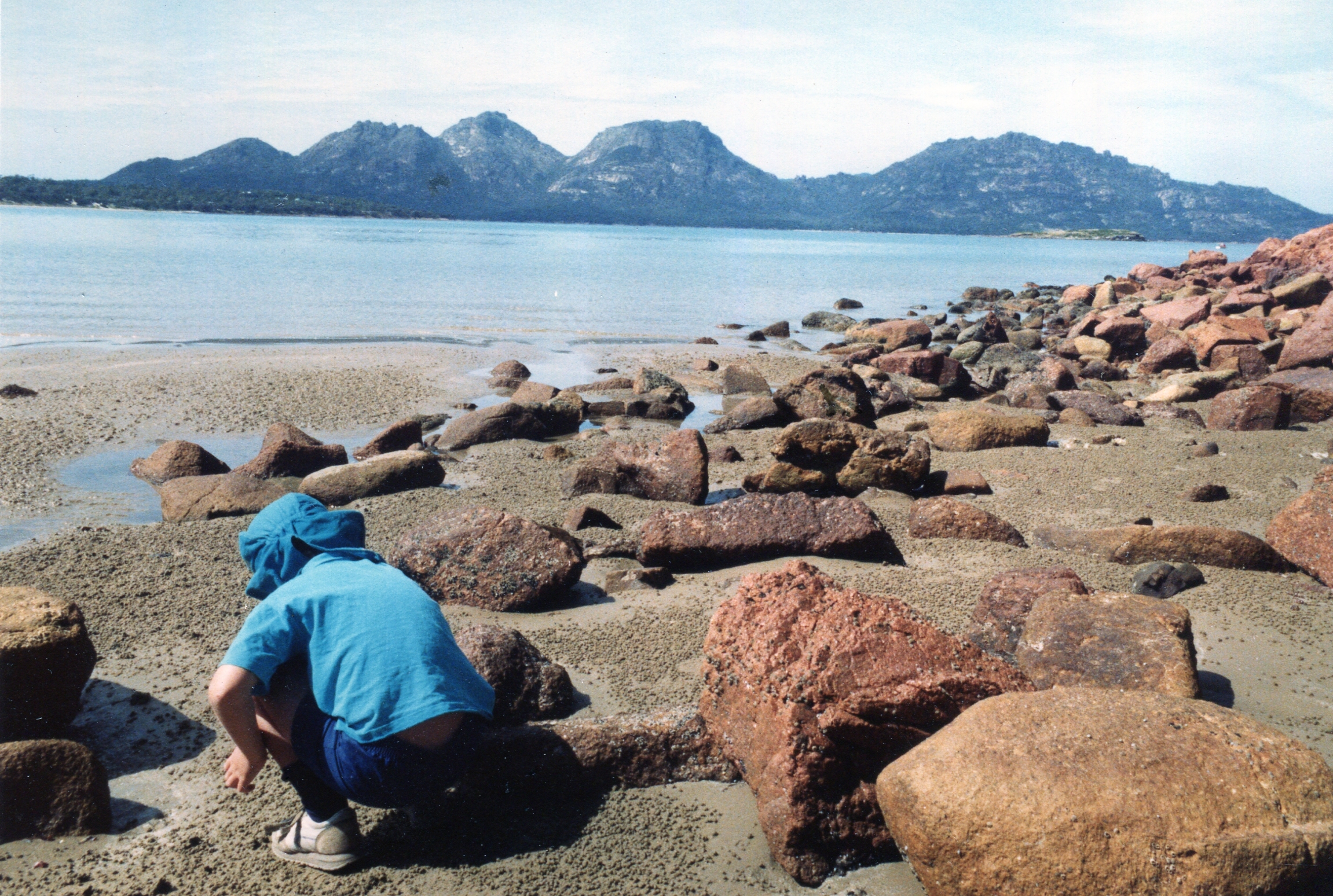
Near the headland, soldier crabs were put through their parade-ground paces by three inquisitive naturalists for at least 20 minutes. The short walk to the end of the headland gave a view of the Freycinet Peninsula with Schouten Island gingerly peeking around the southern end and Maria Island, sphinx like, in the haze near the horizon. As the kids made life hell for at least 60 starfish I talked to Jim who was fishing at the end of the point. His wife, Elizabeth, was wading out into the Bay from the beach and complained loudly, with a proper English accent, that the only pollution in the Bay was one of Jim’s rolly butts. A statement with which I could find no fault!
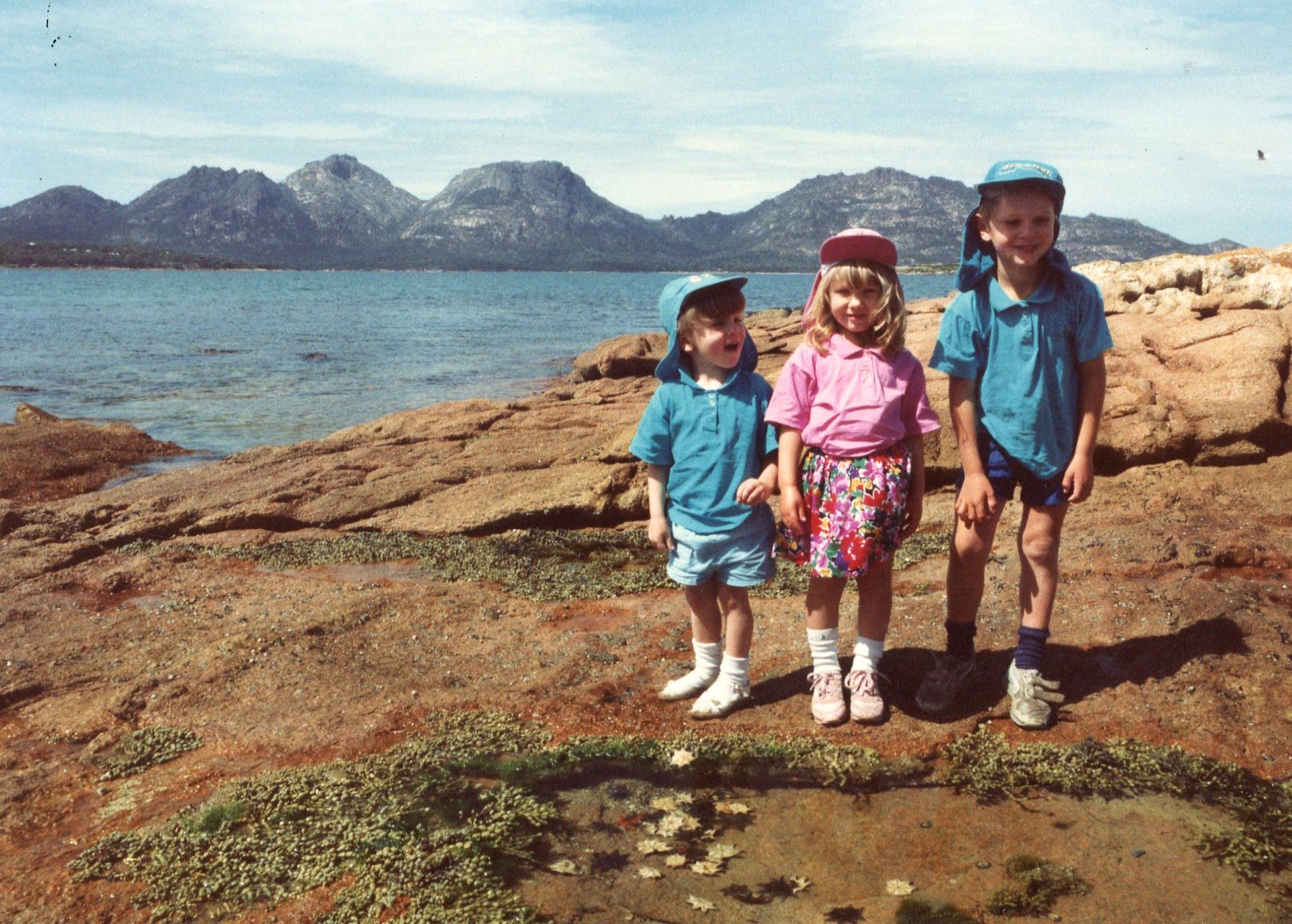
After lunch it was exercise time, so it was off to Freycinet National Park to walk halfway up the track to Wineglass Bay. Halfway because it was a reasonable distance for the kids and gave excellent views. The walk took about 3/4 of an hour to reach a saddle between two impressive granite mountains. Although not especially steep, the walk held difficulties for Rohan as treated pine barriers 15 centimetres high had been placed at irregular intervals to curb erosion. Nevertheless he managed to walk all the way with only minimal assistance.
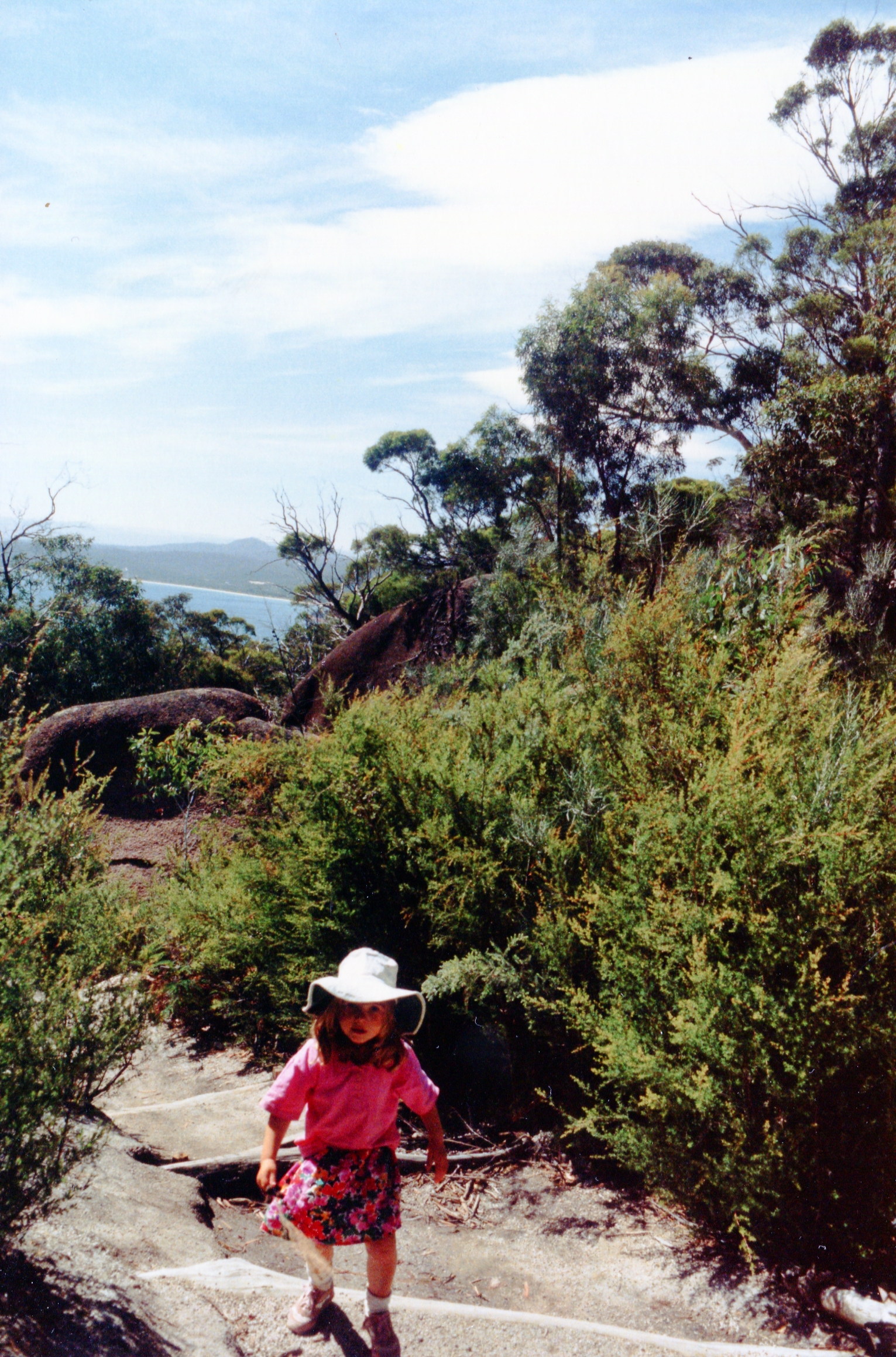
Once at the saddle the views repaid our efforts. To the SE Wineglass Bay revealed a perfect white semicircular beach bounded by heath and blue blue water. Two yachts sheltered from strong NE sea breezes at one end. In the opposite direction Coles Bay and the land around stretched with almost no visible sign of habitation.

We were not the only mammals at the look out. Two hikers had left their packs leaning against trees and climbed higher up the granite boulders for a better view. Also having a better look were two Bennett’s wallabies nosing in the packs for food. Obviously, veteran pack ransackers!
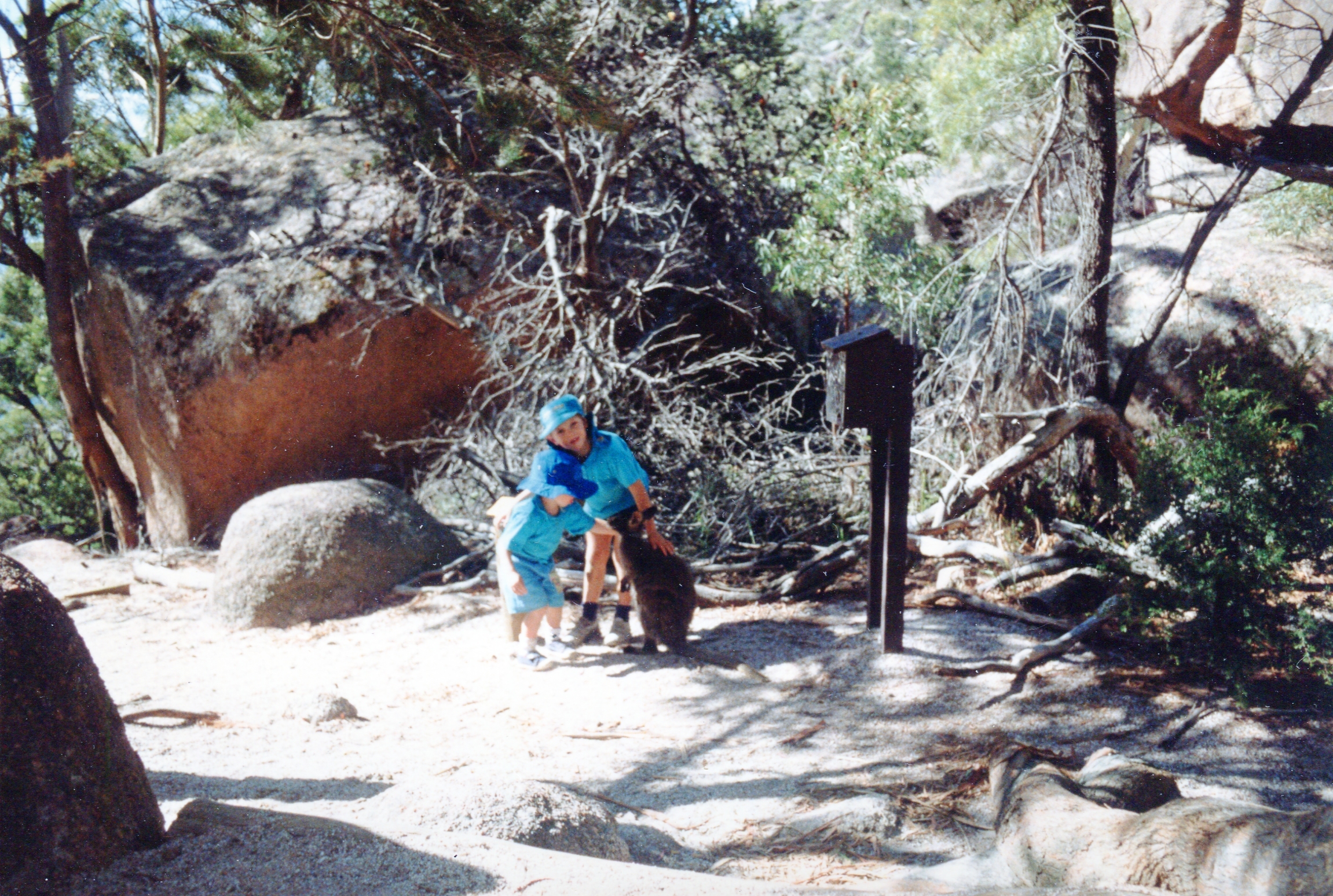
There were three offenders, mum and two joeys, one probably a season older than the other and the smallest was still drinking milk from mum. Being a fellow female mammal Jacqui knew immediately that the mother would require water as joey sucked eagerly, so Jacqui gave the mother wallaby our drinking water. These wallabies were very tame and allowed the children to handle them freely and roughly.
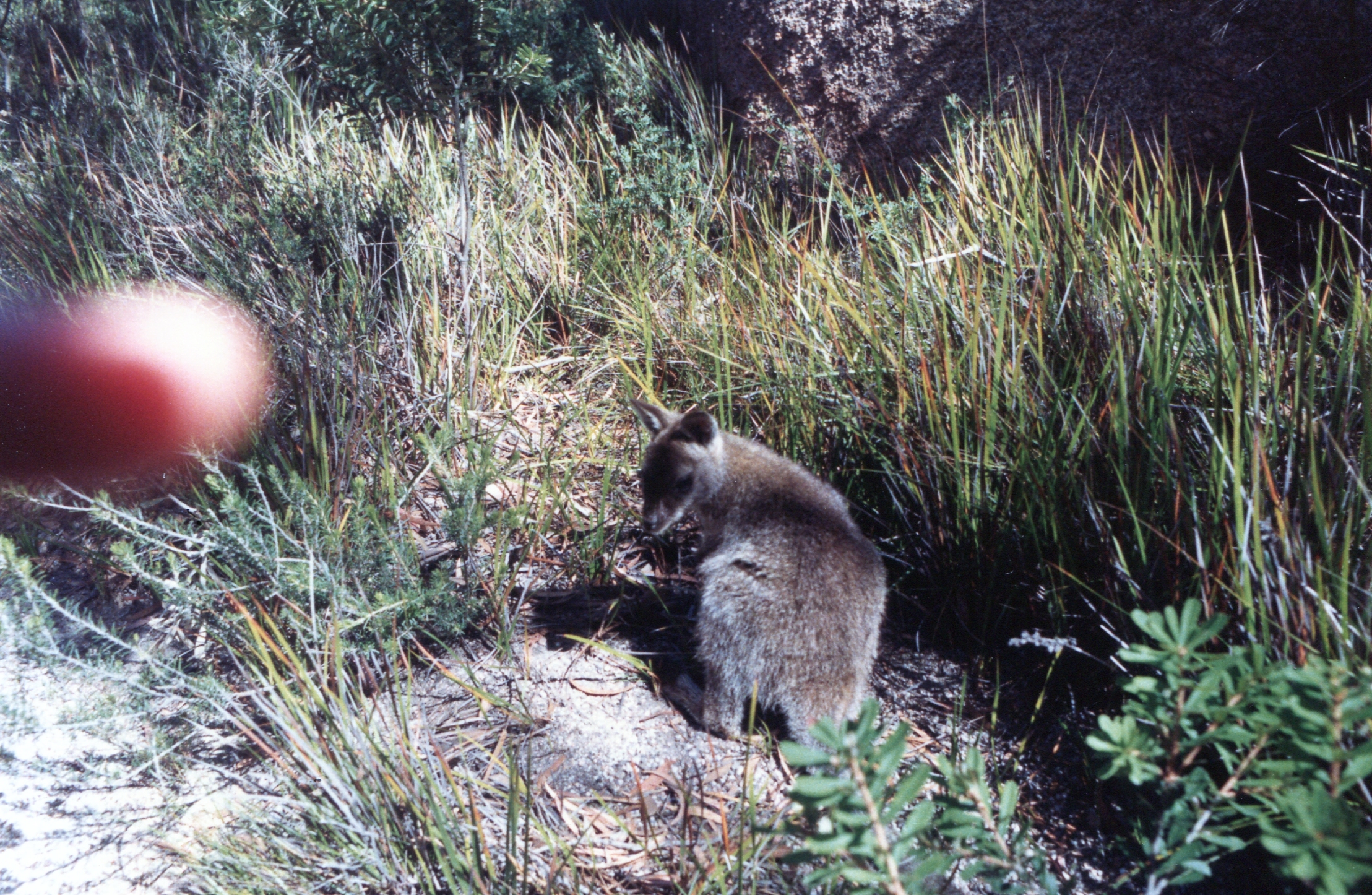
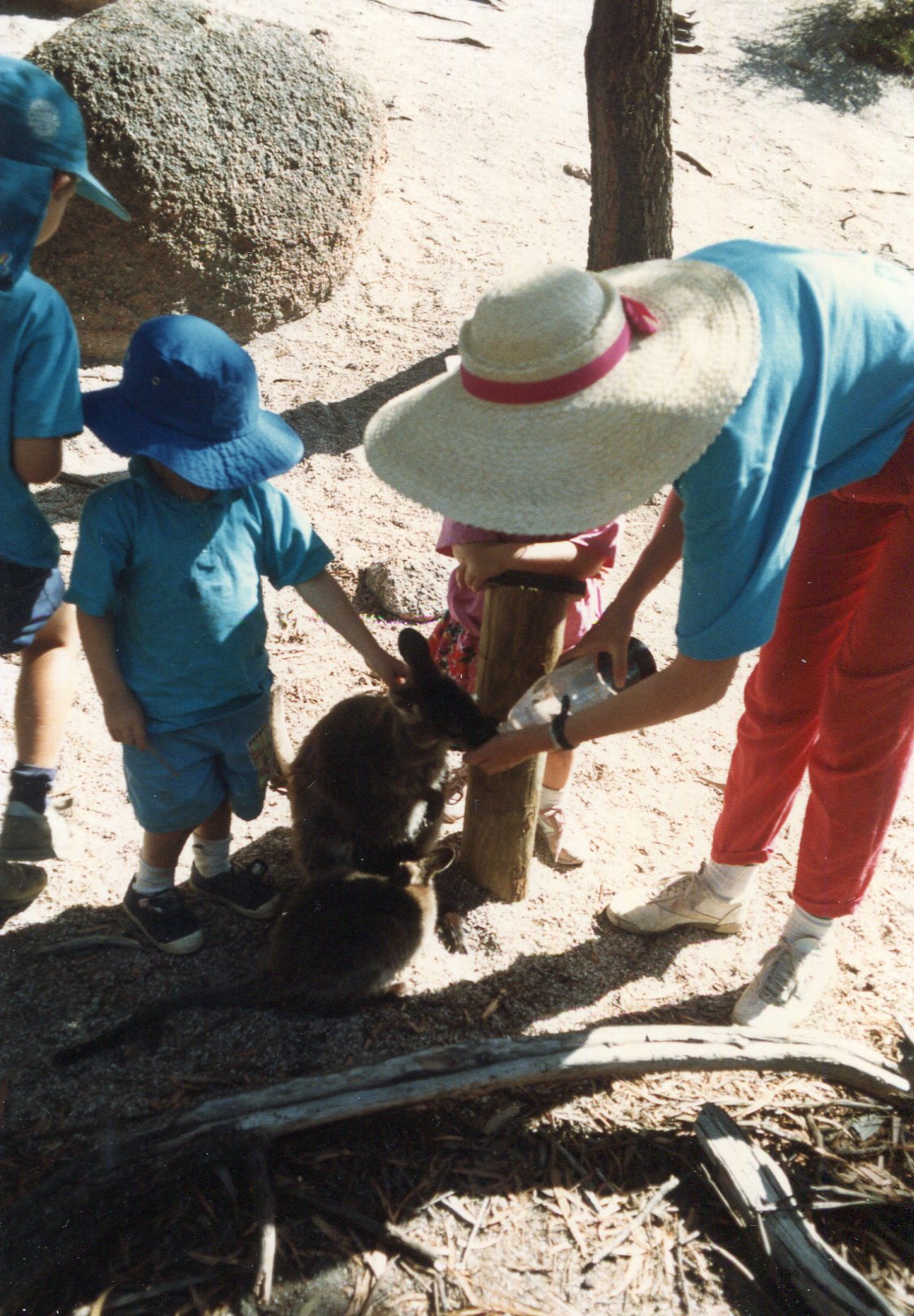
Walking down was harder than the trip up. As the granite weathers small crystals, roughly 2 to 3mm in diameter on the track making its surface almost frictionless. The kids slipped onto their bums frequently and Jacqui and I had quite a few close shaves. At the car park was another troop of Bennetts wallabies obviously training tourists in the fine art of bold begging.
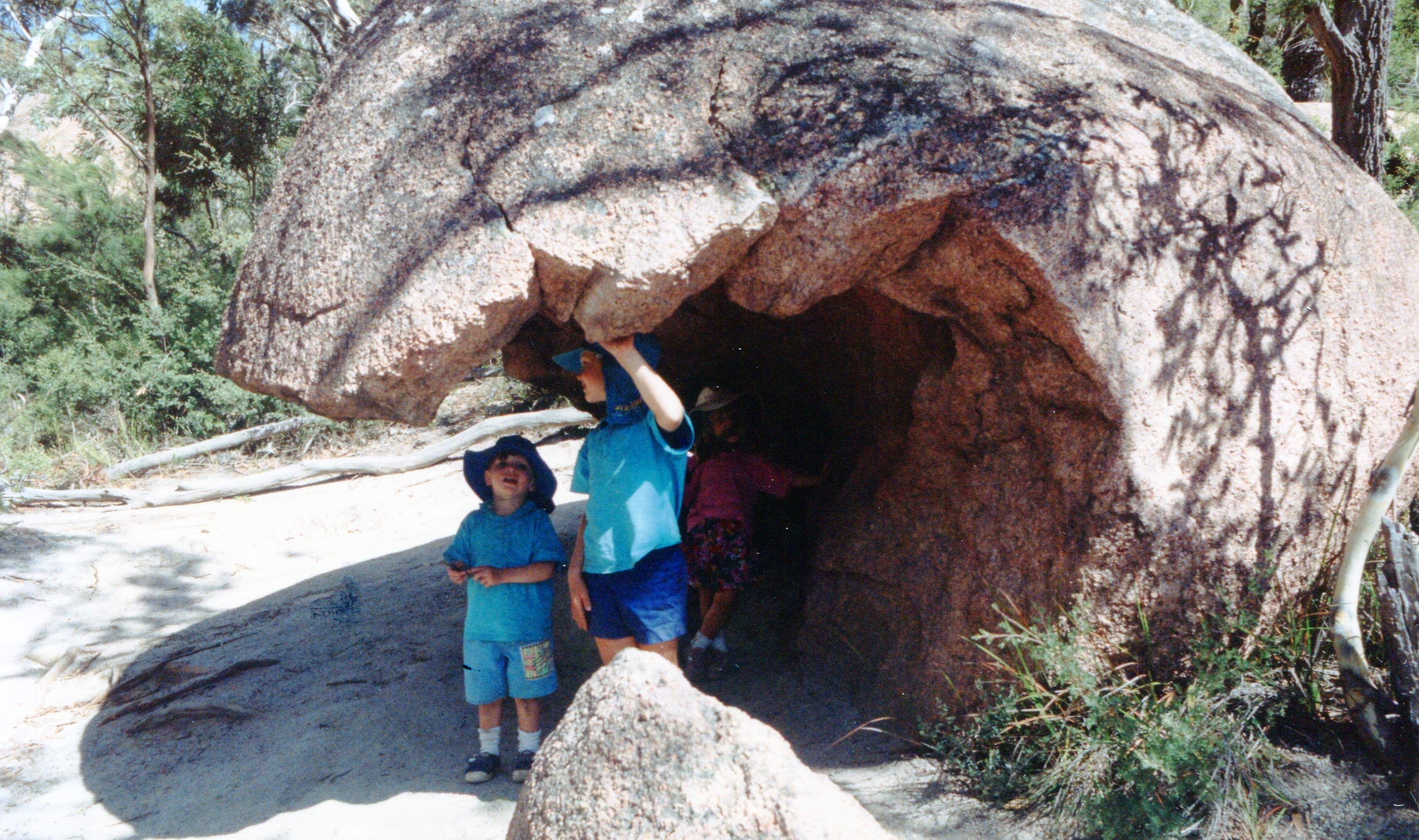
Tuesday 20th February 1990
Breaking all records, we headed off with Jim and Elizabeth for a day at the Friendly Beach by 11:30 AM. Heading back along the road to Bicheno for about 20 minutes we turned off to the East along an unmarked dirt road which brought us to a labyrinth of small camping spots carved out of tea tree scrub near the beach.
After nearly destroying the front of the car by trying to drive into a large granite Boulder – Jacqui could see it from the passenger seat but I couldn't and my attempt to drive into it brought understandable cries of anguish - we ate lunch in a secluded campsite before splitting into two forces. One to do some serious relaxing on the nearby beach and the other to mount a full scale assault on the fish population at another beach 1Km further South.
I have to report that we took numerous prisoners but were forced to release them all when it became clear that the strands of kelp were going to remain tight lipped about the where abouts of the fish. Anja and Lachlan had a great time running around on the clean white sand while Jim and I wasted our time in the second most enjoyable way imaginable.
Back at camp we regrouped for debriefing and a serious cuppa. Disturbing the peace was the drivers of an old Falcon station wagon zooming up the road towing a large tree trunk. Those wankers ought to go home to Victoria was the general feeling expressed by the troops.
Supplies arrived in the unlikely form of a budget camper van and Falcon ute. A group of surfies from Avalon New South Wales were desperately seeking a wave but there were certainly none to be found here today. They did, though, help us out with water for the Billy.
Jim and I travelled indian file back to the Coles Bay camp. We went on into town where Jacqui rang Jo to find that she had accepted an offer of $80,000 for her property 59 Lower Fort St in The Rocks. We also made arrangements to speak to Marco who is at the Australian maritime college at 7:30 PM.
While Jacqui prepared spaghetti marinara I spoke to Marco and we plan to meet on Saturday in Launceston at 10:30 to 11:00 for a day out.
On the way back the kids and I stopped at the wharf for a breath of fresh air and to look at sunset over Coles Bay. What a lovely sight!
Wednesday 21st February 1990
Another moving day! We departed the Coles Bay caravan park at around 12 midday and headed North for Bicheno and in theory St Helens.
At the small fishing village of Bicheno, we stocked up on fruit and money. On the recommendation of George and Sue Cochrane we ate lunch at the Bicheno wildlife park. Then, after forking out $14.50, we spent an hour or so being following around by birds, mainly water birds of one type or another, and some wallabies who wanted to eat the food we had declined to buy for $0.40 per packet.
The highlight were the Tasmanian Devils. They were lying upside down, genitals exposed, sound asleep as they are nocturnal and sleep all day. There was also a huge aviary that housed a large number of pretty birds.
After the obligatory ice cream, it seemed only an instant before we pulled into the best little crayfish shop this side of Stanley. We got a huge crayfish, cooked this morning, as well as a lesson on the finer points of eating same. About 5 minutes later we were back at the shop asking directions to a new road which bypasses St Marys and a steep climb called Elephant Pass. The proprietor could read my mind as she gave directions even before I opened my mouth.
After only 10 minutes travelling along this excellent road which parallels the sea we decided to checkout a no facilities camping area signposted from the main road. Here we found a flat grassy area, near a freshwater creek that feeds a small lagoon behind a little beach nestling between 2 rocky granite headlands. It was perfect!
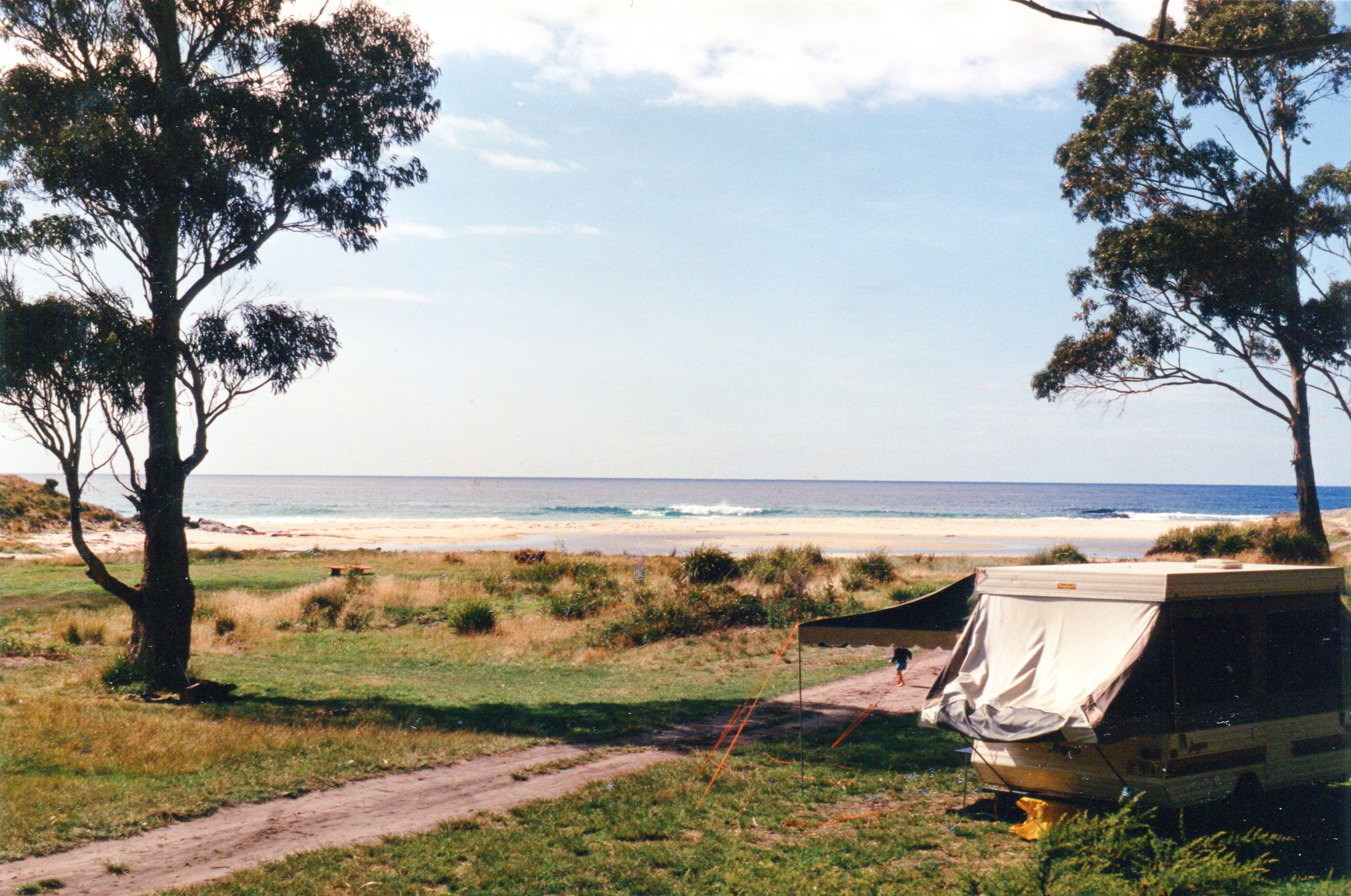
After setting up camp, collecting wood and preparing chips and salad we cracked a bottle of champagne to accompany a superb crayfish dinner. Lachlan was impressed and called the crayfish “superb” and said “it was like Christmas and the best meal he had ever had.” Much to our delight Anja and Rohan didn't eat their share – the more for the rest of us.
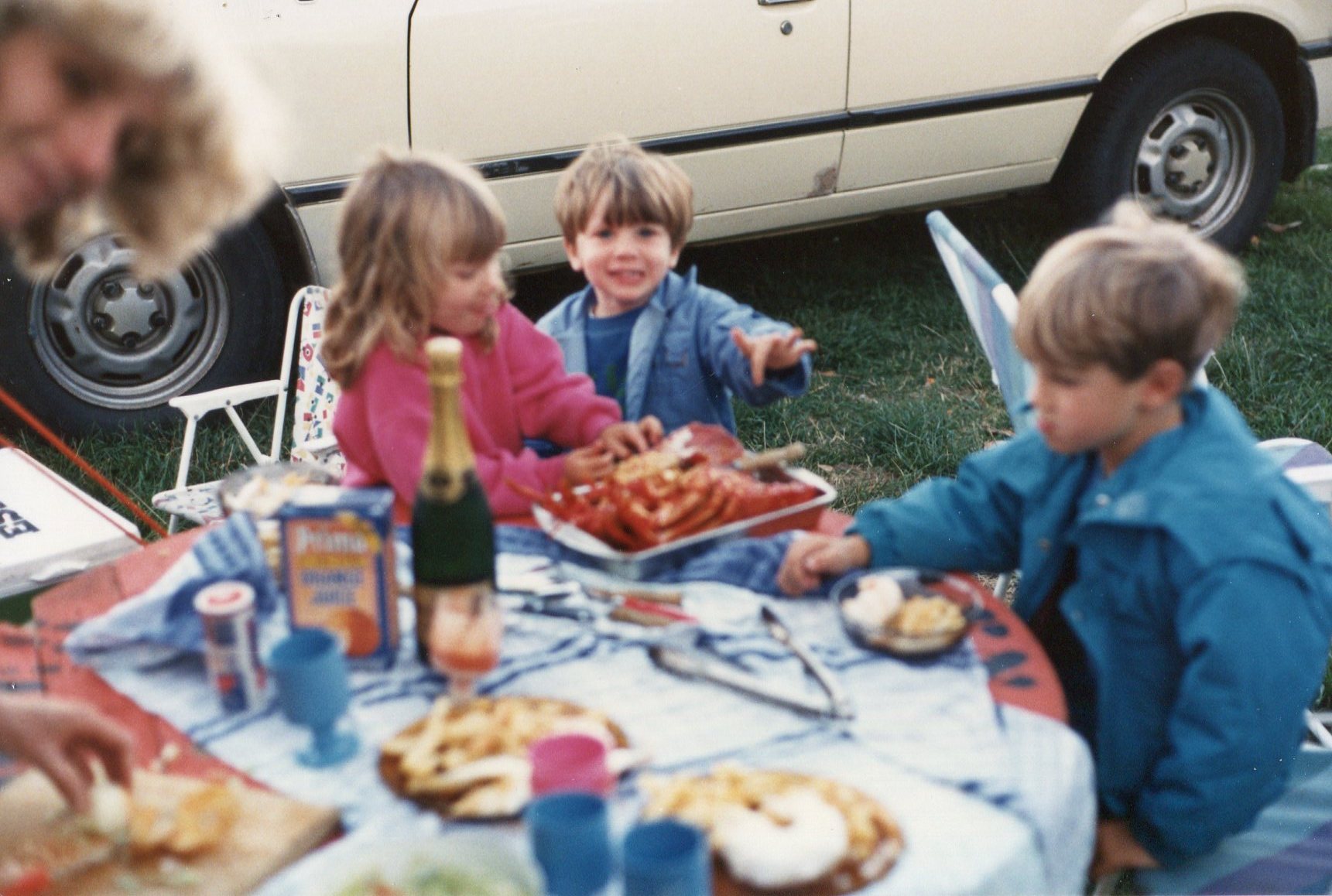
Anja and Rohan appeared impressed with the crayfish meal - but they didn't eat any of it!

The local council made creative use of old cable drums. We rolled it under our annexe and it made a very effective picinic table.
We all bathed in the picnic basket with the Creek water heated in the fire.
Thursday 22nd February 1990
The wind died around 11:00 PM, but it clouded over and remained unusually warm for a Tasmanian night. Too warm, in fact, to be comfortable under our doonas.
Waking at around 8:00 am I decided to make the most of the almost windless condition, and go for a dive. Jacqui stayed in the van and gave the kids breakfast. We were both a little hesitant about me diving without someone watching, but I promised to call it off if conditions were dodgy.
As it turned out there was a reasonable breeze and a one metre swell with occasional larger waves. I watched for quite a while before going in. If I chose my time for entry and exit there would be no problem.
Without difficulty I slipped into some relatively deep water and struck out away from the rocks. Huge kelp clung to the rocks both near to the shore and on the exposed boulders further out. The kelp fronds (if that’s what they are called) were thrashing back and forth as the swell rolled in and out. On the bottom, the sand was stirred as the larger waves passed above. I swam for quite a while and saw only a few “kelpies” (brown reef fish that are not good eating) and one red mowong which shot off like a startled rabbit when it saw me. Disappointed, I headed back to shore spotting some blackfish under a large boulder in about 20 feet of water. I went down, peered under the rock, and managed to shoot one. After putting it on my float I was washed in towards the rocks where I stumbled on a hole, very close to the breaking waves, which was alive with fish: kelpies, drummer and red mowong. I shot three more fish, two mowong and one more drummer, but it could have been 30 more. Eating and storing that many would, though, have been a problem.
Loaded up with 3-4Kgs of fish - they were big - I headed back to my exit point. Here I let the waves carry me through a narrow channel in the kelp and then up onto the sloping ramp I had chosen. Washed halfway up the first time, I clung to the rock as the backwash did its best to force me back into the water. The next wave was larger than I would have preferred, and I had to fend off the rocks as it drove me high and dry. From there the walk out, even in fins, was okay but I was tired.
The joint pattern in the Saint Marys porphyry provided an excellent fish cleaning shelf with ample clean water. After this task, I spoke to Mike and Brendan, 2 young blokes in their final year at the Australian Maritime College doing the same course as Marco. They were camped on the headland and I told them where to catch the best fish.
Back at camp, Jacqui gave me brekkie and a much-wanted cuppa. Lounging around after breakfast we were surprised to see a convoy of about 6 vehicles drive in and park in a circle, wagon style, over the road. Most had University of Tasmania stickers on the side and the g-picks that appeared, suggested a geology field trip.
I walked over and asked if I could tag along. At almost the same time it started to rain, so we - about 28 students, eight of which were girls, 2 PhD students and one lecturer - tramped off becoated to the headland. Here we were shown contact between a granite dyke and the surrounding St Mary's porphry. This rock is thought to be extrusive and consists of welded ignibrites with fused pumice intrusions as well as numerous zenoliths [2020 note: says Ian showing off his geological background and ability to memorise what the lecturer had said]. That an extrusive rock can appear so granitic in terms of crystal size, gives an indication of the size of this geological body.
Of nearly as much interest as the rocks were the students themselves. This was the last day of a 7 day, second year, geology field trip. Many had partied every night until the wee small hours. The hangdog expressions were not due entirely to the continuous heavy rain and the umpteenth rock platform lecture. One small red-headed young woman sat, head bowed, without a raincoat on for the entire visit, until, that is, the lecturer called on her to explain some complex feature of the contacts zone to the assembled masses. I felt sorry for her, because in my university geology days I had been in pretty much the same position.
One of the PhD students was interesting as he had a family of three children of similar ages to our own. He and his wife, a medical doctor, had travelled around Australia in 1988. They drove 44,000 kilometres in an old Land Rover, camping in a tent during their eight month journey. We compared notes.
Returning to camp where the soft rock lecturer had prepared lunch over a fire, many ate in the shelter of our annex. We helped by boiling their billy, something the rain-subdued fire was having difficulty achieving. We spoke of many things to do with travelling, geology, PhDs, mutual acquaintances, and the affect government policy is having on universities. When they left, they gave us milk, biscuits and sugar. Thank you!
After lunch we encouraged, cajoled then threatened to make Lachlan finish his lessons. This achieved, we drove up Elephant Pass to Saint Mary's, about 20 kilometres away. where we posted a few letters, stocked up on some supplies and left after only half an hour in the small rural village.
As we had promised the kids, upon our return, it was off to the rock platform to show them what I had seen with the University group. The weather had cleared so we took a billy and, on the way home, spent 20 minutes collecting blackberries for dinner.
We roasted potatoes in foil and cooked 2 large drummer on the hot plate. Not quite as good as crayfish but excellent all the same!
Friday 23rd February 1990
Having saved $20 on the cost of a camping ground by staying at Sandy Beaches for free, we decided to spend it. While Jacqui was packing up, I drove with the kids to Wardlaws Store at Chain of Lagoons. Here I purchased an $18.00 Cray and a $1 pot of seafood sauce. For this extravagance I was chastened by Jacqui who said she could whip up a seafood sauce in a trice and for far less money.
We headed north, in clear sunny conditions, at around 11:30 AM. Our first stop was St Helens where we picked up a letter from Elaine. The kids loved their individual letters and it was good to hear news from home.
Lunch was at St Columba falls where we shared a picnic table with three old ladies from Wynyard, a town on Tasmania’s north shore. Politically they were somewhere right of Genghis Khan. Jacqui senses this immediately and proceeded to make controversial statements scoring 10/10 for shit-stirring.
The falls were big, wet, and impressive. We “did” St Columba falls. The crayfish we had for lunch was small, white, delicious and will be remembered long after we finish out trip! [2020 note: sorry to my past self, I can’t remember the crayfish, but nore can I remember the falls]
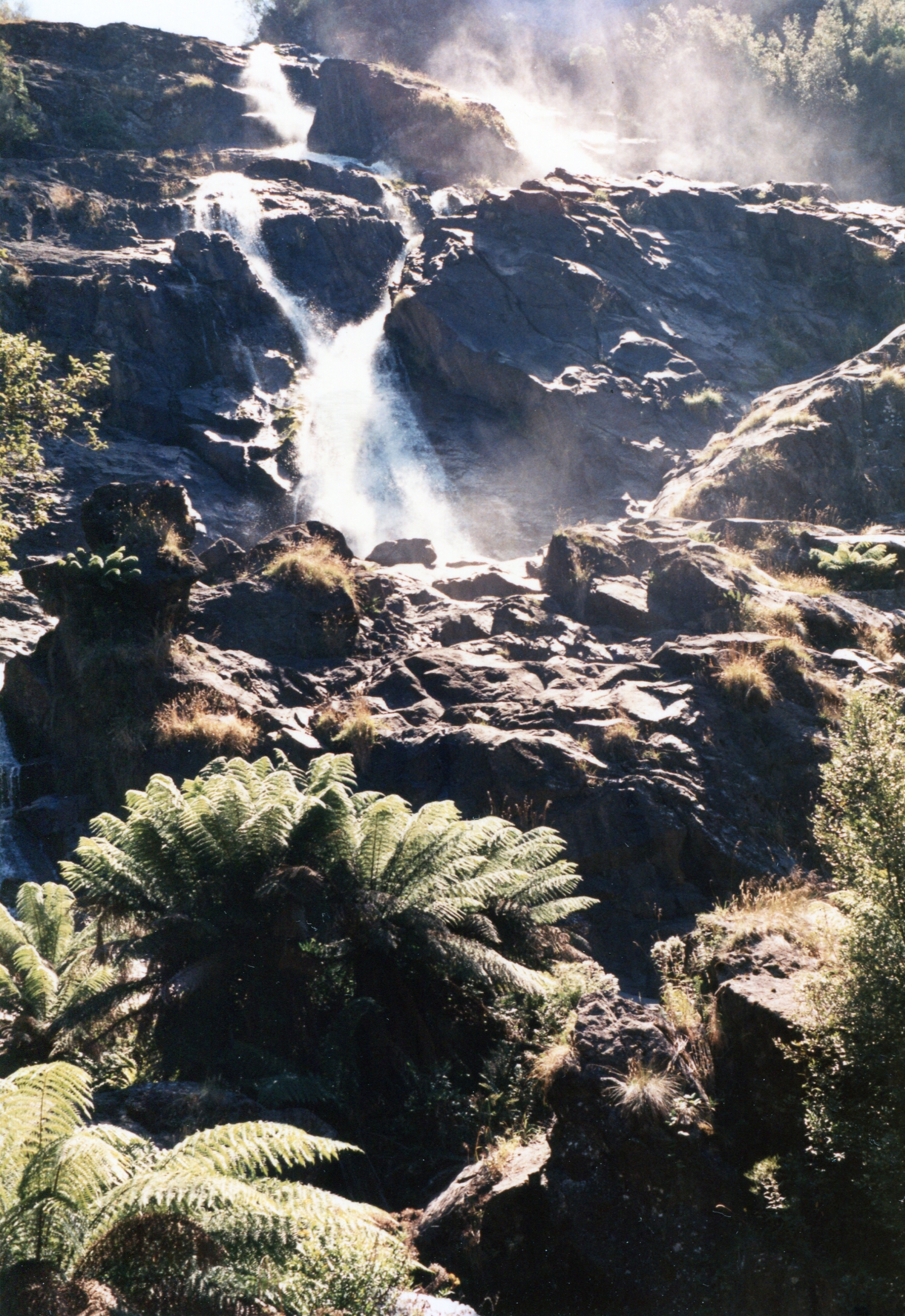
Yep, we "did" St Columba falls
On to Scottsdale where we revived the troops with an ice cream and made the necessary trips to the loo.
The road both before and after Scottsdale was typically Tasmanian. I have decided that huge sums could be saved by having signs which read:
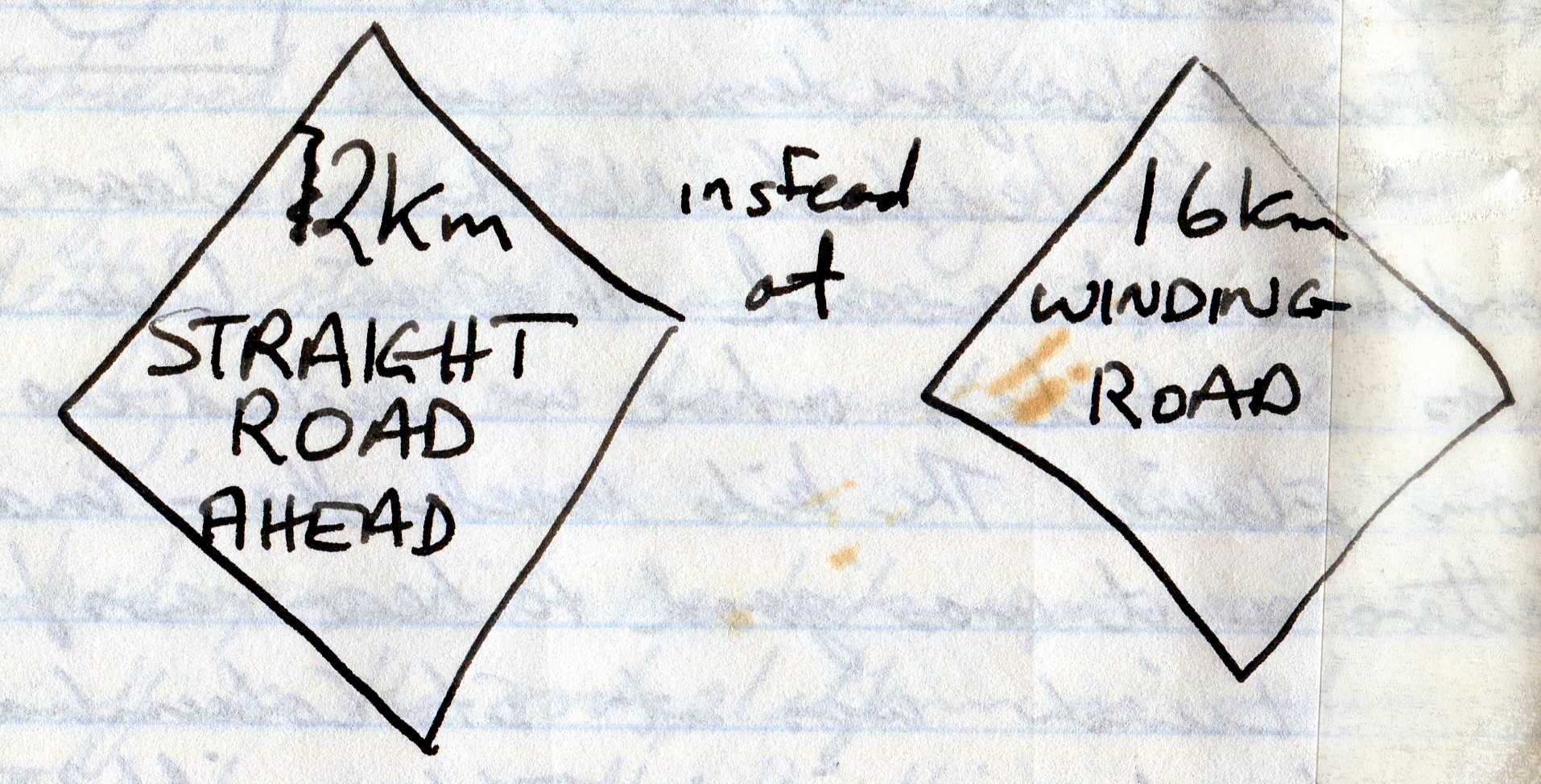
As we started to climb a large Hill about 5 kilometres out of Scottsdale [2020 note: this hill is a famous part of the Targa Tasmania rally and is called the Sideling] we came up behind a large semi-trailer loaded with sand. His driving impressed us and Jacqui and I talked about the difficulties of driving big trucks around this state. I called him up on the CB radio and we chatted on about places to see, fishing, walking, driving and other things. This helped pass the time and before long we were almost at Launceston.
In Launceston we got money, groceries and filled up the gas bottle which was empty for the first time since leaving home. $15 bought us 9Kg of propane. A bargain considering the use we’d had from it!
Then followed a late setup at the Launceston Caravan Park, dinner and finally port, coffee, and chocolate.
Saturday 24th February 1990
After some skilful navigating by Jacqui, we picked Marco up, in brilliant sunshine, at the Australian Maritime College (AMC) at around 11:00 AM.
The pleasure at seeing someone from home was mutual, although the kids seemed a little shy as Marco showed us his compact one-room accommodation.
From the AMC we drove into the city, parking easily before heading to a newsagent for this diary [2020 note: Ian is refering to a blank paper diary as we had filled the first volume and would fill a total of 3 diaries before the trip was over] and Myers for two more video 8 tapes and a new pillow for Jacqui. The final stops for bread and lettuce before following Marco’s directions to the Gorge where we spent most of the day.
The Gorge is birdsnest in shape, surrounded by imposing basaltic hills, with a large natural lake, extensive grassed areas, a swimming pool, restaurants and tea rooms, suspension bridge and cable car. Most of the remaining part of the morning and after a lunch of cold chicken salad and apple cider we grilled Marco about his course at the AMC as a BHP deck officer cadet. Our lunch was shared by a mini swarm of around 20 european wasps. Their taste seemed to run mainly to chicken, ignoring the sweeter items on the table.
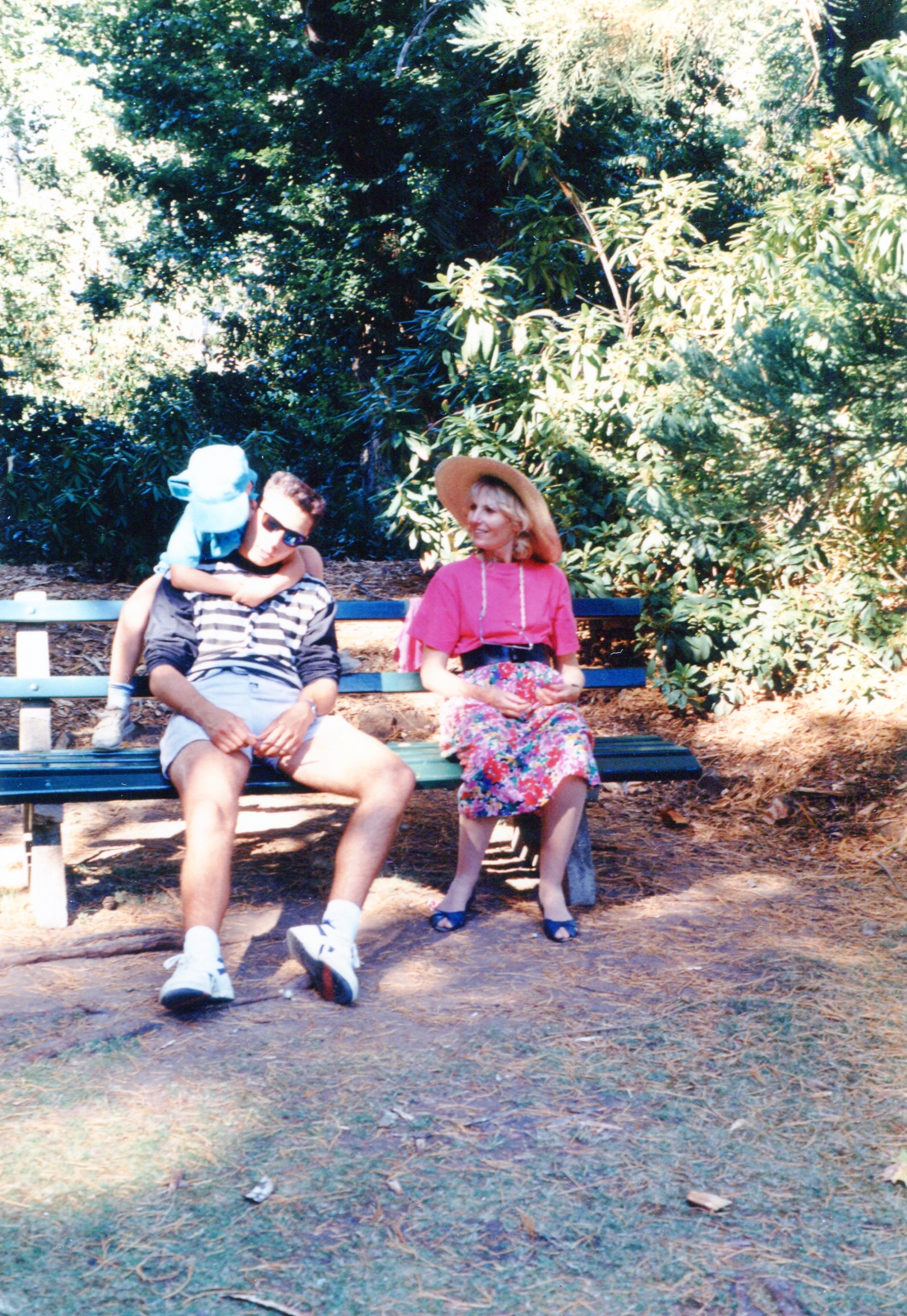
Lachlan soon attached himself, limpet like, to a very patient Marco
The kids swam in the huge shallow wading pool and played on the playground equipment while we sat in the shade of English trees near the beautiful tearoom-restaurant. From time to time a ripple of breeze would cause a seed to fall from its tree. Each seed was suspended by a specially designed seed-leaf rotor blade which rotated, helicopter like, ensuring the seeds landed as far as possible from the parent tree. The seeds looked like this:
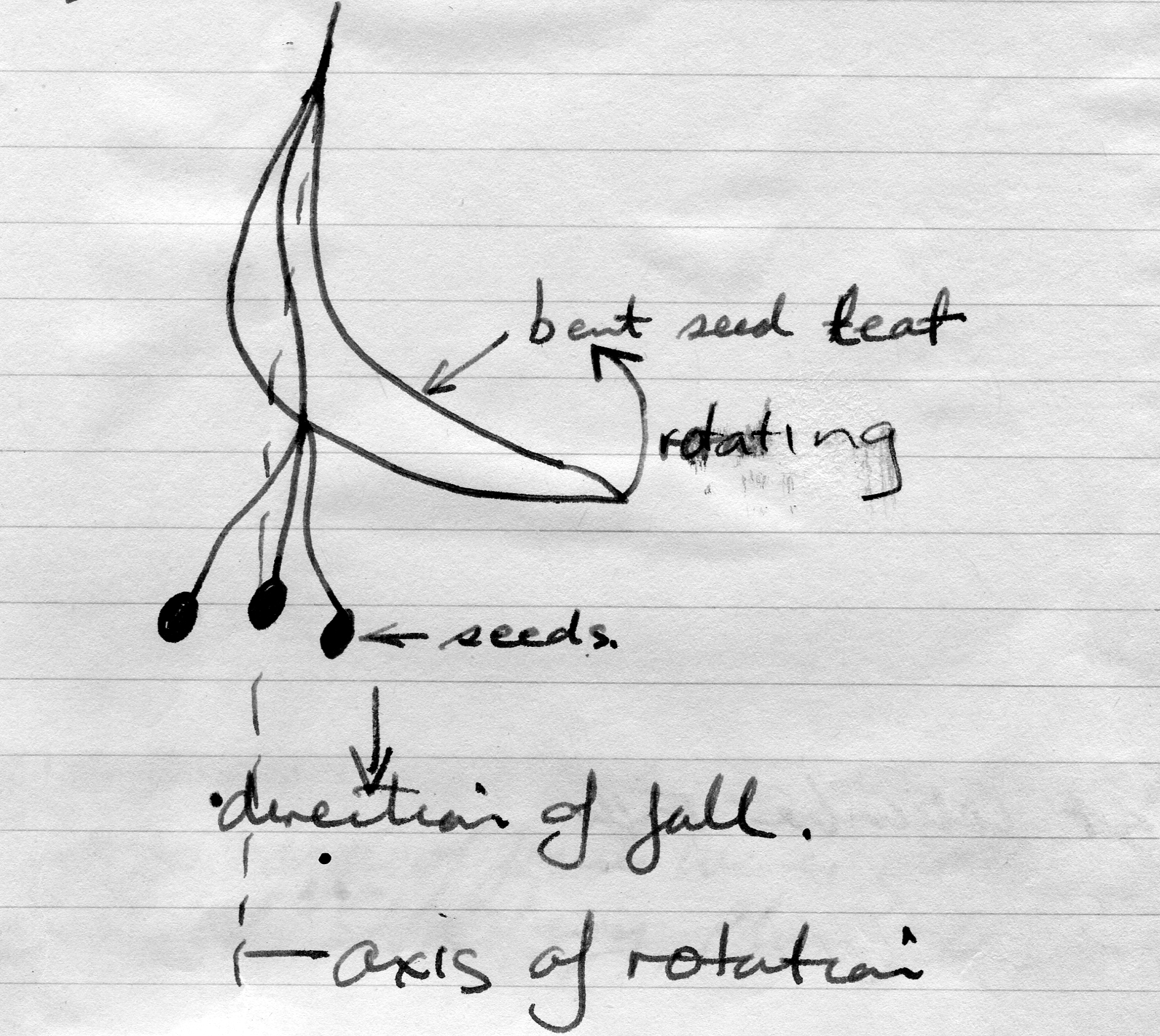
Leaving at about 5:30 PM we drove for a while looking at the scenery of Launceston. Leaving the car near the centre of town we walked to a large park where we watched wallabies and children play. Finally, feeling hungry, we settled on Pierre’s coffee lounge. Buying wine in the nearby pub I saw Pipers Brook vineyard wines but didn’t buy any as they were out of our price range at around $22 per bottle!
The meal was excellent and, being in an alcove, the kids could be kids without disturbing other patrons.
Marco came back to the van for coffee and provided chocolate to the kids’ delight. I took him back to the AMC at around 10pm.
Sunday 25th February 1990
We picked Marco up at 11:00 AM and headed north to the Hillwood strawberry farm around 25Km from Launceston.
Here we were provided with 2L and 4L buckets to pick as many strawberries as we wished for $3.50 per Kg. Like kids in the candy store we picked about 4Kg but if the proprietor had weighed us in and out, I'm sure we would have been asked for twice as much money.
The proprietor also had a range of fruit wines made from his fruit. They included strawberry, plum, black currant, loganberry and raspberry. We tasted them all and Marco bought a loganberry for lunch and a bottle of strawberry for later. They were expensive at $14.00 per bottle. Freight to Sydney was $10 per dozen.
We settled ourselves into the shade and ate chicken and salad rolls with the loganberry wine, followed by strawberries and ice cream. The consensus seemed to be Yum Yum!
Backtracking through Launceston we filled the car, rode the cable car at the Gorge, lodged the remaining perishables and strawberries at the van, took some fish and abalone out for dinner and headed South for Evandale. Evandale is a small village with two streets where all the authentic 1860s houses and stores are colour coordinated. We walked the length of the main street three times, stopping to browse in the bakery which had bread and other crafty stuff before hitting the pub’s beer garden for a Boags.
Having “done” Evandale we moved onto Langford. This time we didn't even stop the car!
Back at the van we cooked up a feast of abalone lightly fried in butter, chips and red mowong washed down with champagne. Moving outside we stuffed ourselves on the remaining strawberries, about 2Kg, and drank the best part of the bottle of sweet strawberry wine. Driving Marco back to the AMC we listened to, and added appropriately silly comments to, the locals talking on the CB radio. [2020 note: clearly, we weren’t concerned about being caught for drink driving]
Monday 26th February 1990
Marco rode his bicycle to us this morning and we all packed into the car for a trip to the Waverley woollen Mills.
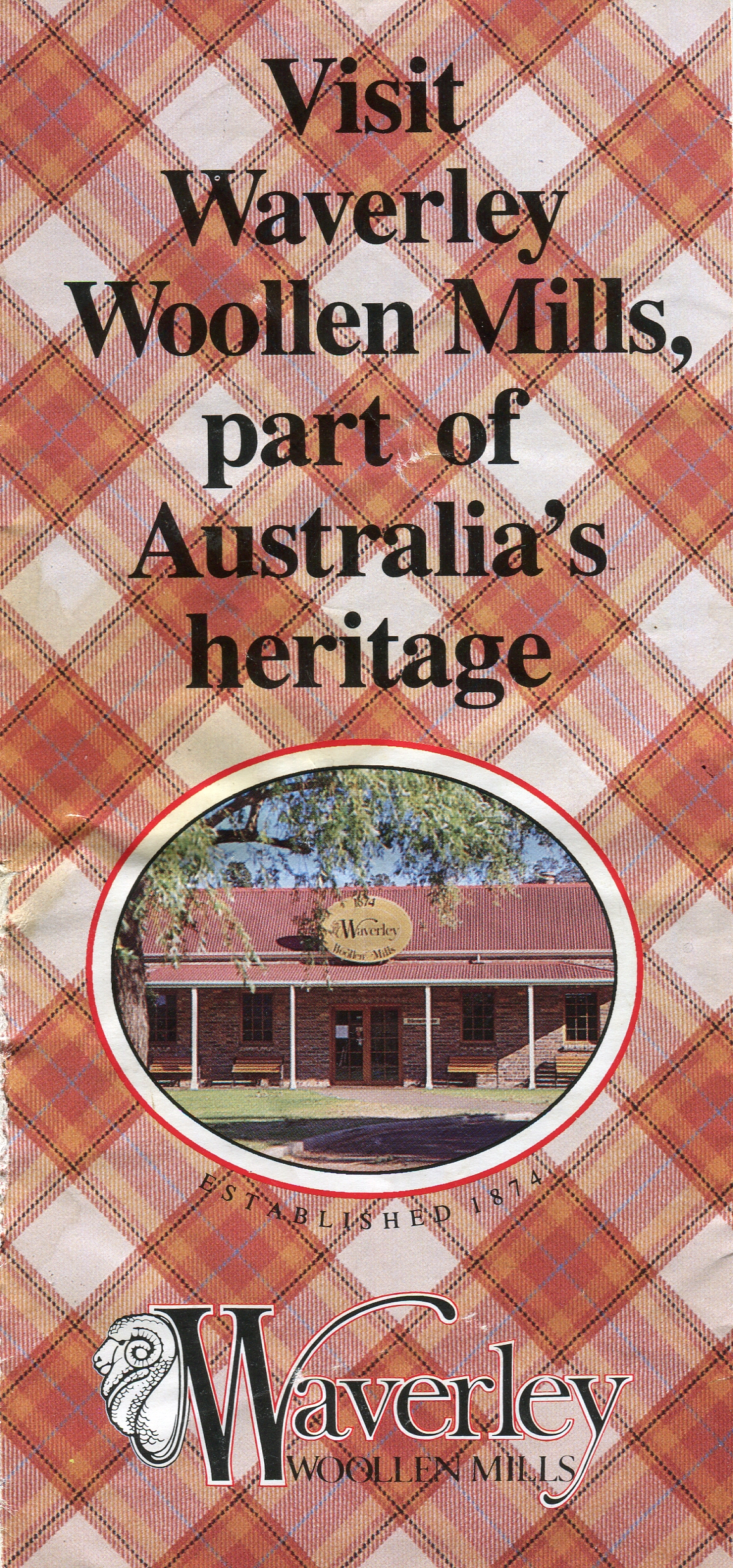
A tour of the Mill showed how the wool is washed, dyed, combed, spun and finally woven. Almost all the equipment looked
original from the mill which was first made last century. I suppose if it works why change it must be the attitude.
The mill stayed in the same family until 1981 when it was sold to its present owners. They changed from making only blankets (the doona killed the old mill) to producing a wide range of clothes including tartans etc. The mill is once again in the hands of receivers due to the downturn in the tourist industry resulting from the pilots’ strike - most of their sales must have been made from the store attached to the mill making it financially dependent on tourists.
Lachlan and Marco had a wonderful relationship
Buying bread on the way home we had some lovely fresh bread sandwiches at around 1:30 PM. Marco stayed for a short while and played with the kids. I'm sure they'll miss him as we all will. It was great to see someone from home again.
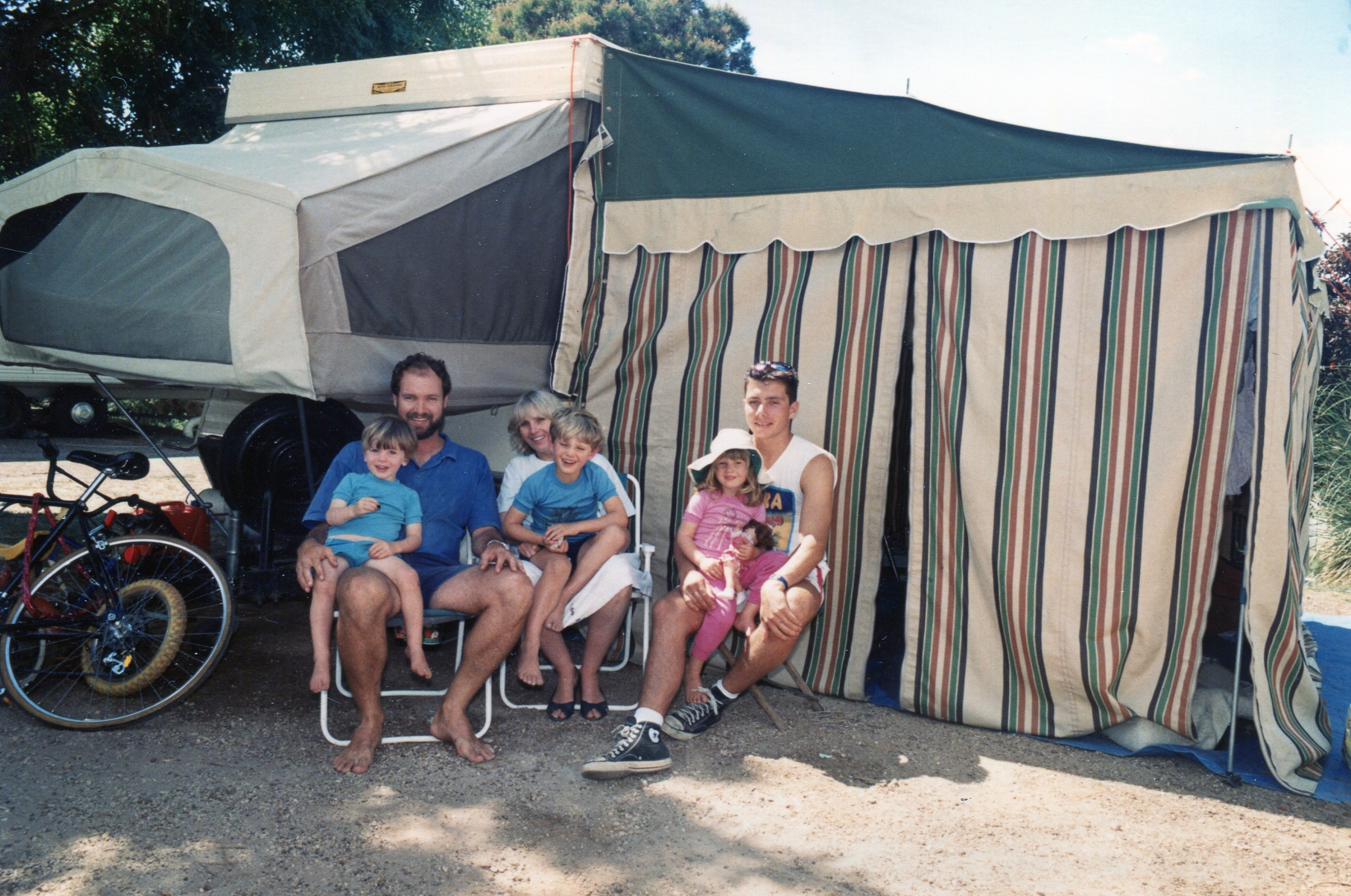
The rest of the afternoon was spent with Lachlan’s lessons, returning library books and getting ready for an early departure tomorrow.
While I was in the library and the kids were playing with the toys thoughtfully provided, I read a few newspapers and noted that education was still front-page news in last Saturday’s Sydney Morning Herald: teacher shortages! Also, our isolation from news was highlighted when I was surprised to read of the “great debate” between Hawke and Peacock! [2020 note: 1990 was a Federal election year]
Tuesday 27th February 1990
Neither Jacqui nor I slept well last night. Whether this was caused by the thought of packing up, the boat trip or at seeing Mum and Dad I can't say.
We were up early, for us, and packed and on the road by around 10:00 AM. After stopping for ice and food we headed north to the Hillwood strawberry farm. Here we picked 2Kg of strawberries in around 20 minutes and then we were on the road to Pipers Brook to see Mark and Ailsa Brewer.
Travelling along what appears to be the most direct route is not always the quickest as some of the roads we drove were dirt, narrow and winding. We arrived at around 11:45 AM. Ailsa met us and giving us tea and homemade apple tea cake – yum! Whilst Mark was out fixing a pump Ailsa showed us around the vineyard. We walked along the red soil roads and looked down the narrow, arrow-straight rows of pinot, chardonnay and riesling grapevines. The red grapes had recently changed colour and the green varieties were in tight bunches of small berries.
As this is a cool-climate region, Mark has the vines in closely spaced rows with each individual vine only about one to two metres from the next. They have been carefully trimmed of leaves to ensure the berries receive sufficient sunlight to encourage ripening. As we walked, we could hear the double boom of the bird scare cannons scattered around the vineyard.
The winery was a uniquely style building which can be seen on their promotional literature. The managing director’s house is similarly styled and was nearing completion. Seated outside the bottling room were 5 people operating the sparkling knew and obviously expensive bottling equipment. At the back of the vineyard, foundations were being prepared for a significant extension. Just off the road back to the house were grapevine canes, planted in densely packed rows, neatly labelled with their variety. Some were even bearing fruit. The youngest vines we saw were one year old, but the three-year-old vines were bearing large clumps of fruit.
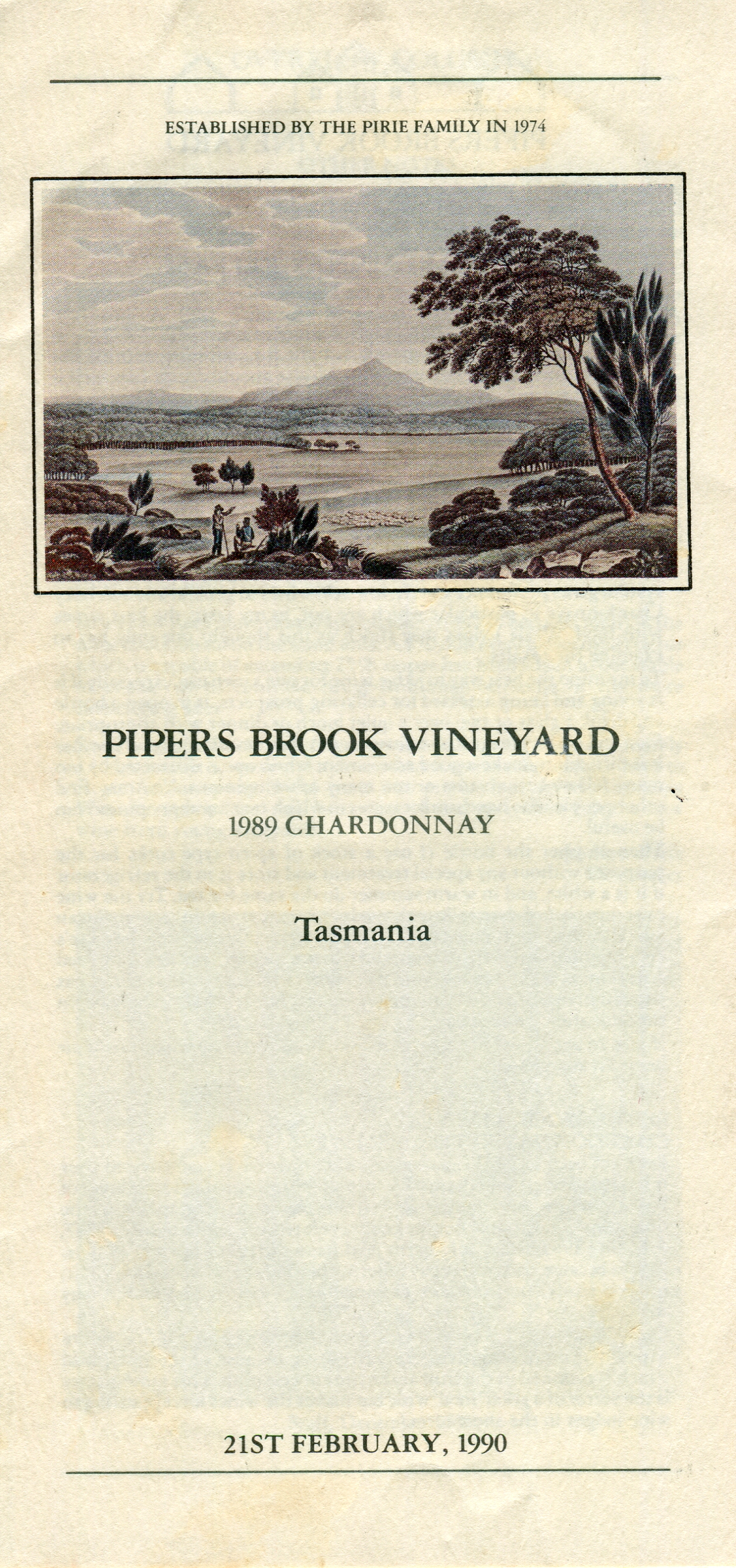
Mark arrived shortly after 1:00 PM and we sat down to a superb meal of quiche,salad and egg sandwiches (the sandwiches our pedestrian contribution). To accompany this feast Mark provided a bottle of Pipers Brook, what else, riesling, an elegant dry wine with high acid and a subtle fruity nose.
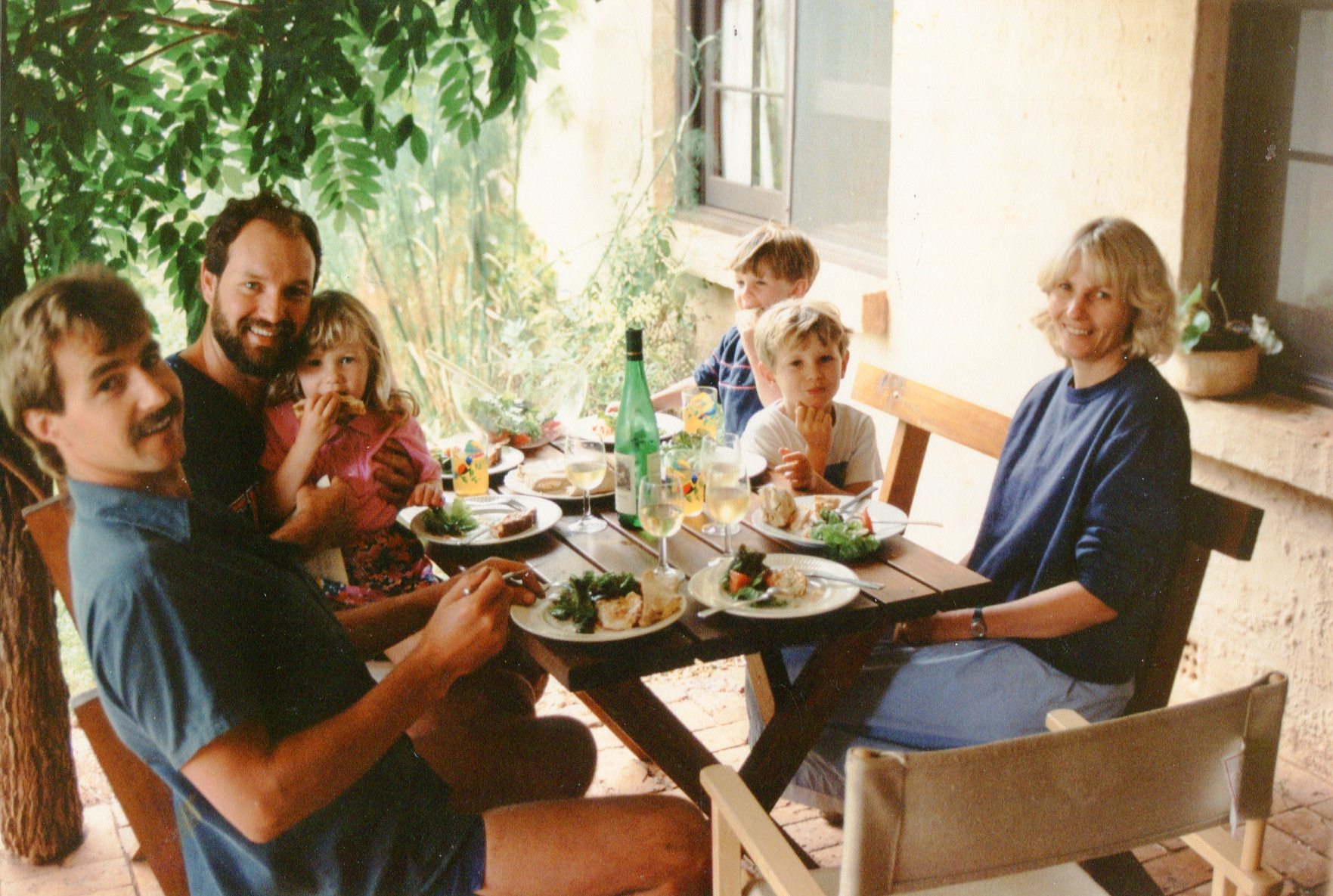
Lunch with mark and Ailsa Brewer at Piper's Brook. Ailsa Brewer photo.
Unfortunately, we couldn't stay long as we had a boat to catch. We left at around 1:50 PM. Both Jacqui and I were envious of the Brewers home, job and lifestyle.
A note from Ailsa Brewer
We had returned home when Ailsa sent this note. The video she mentioned is in this section of the blog. Ailsa, Mark, and Amy did not get to see it until about 30 years later, in March 2020.
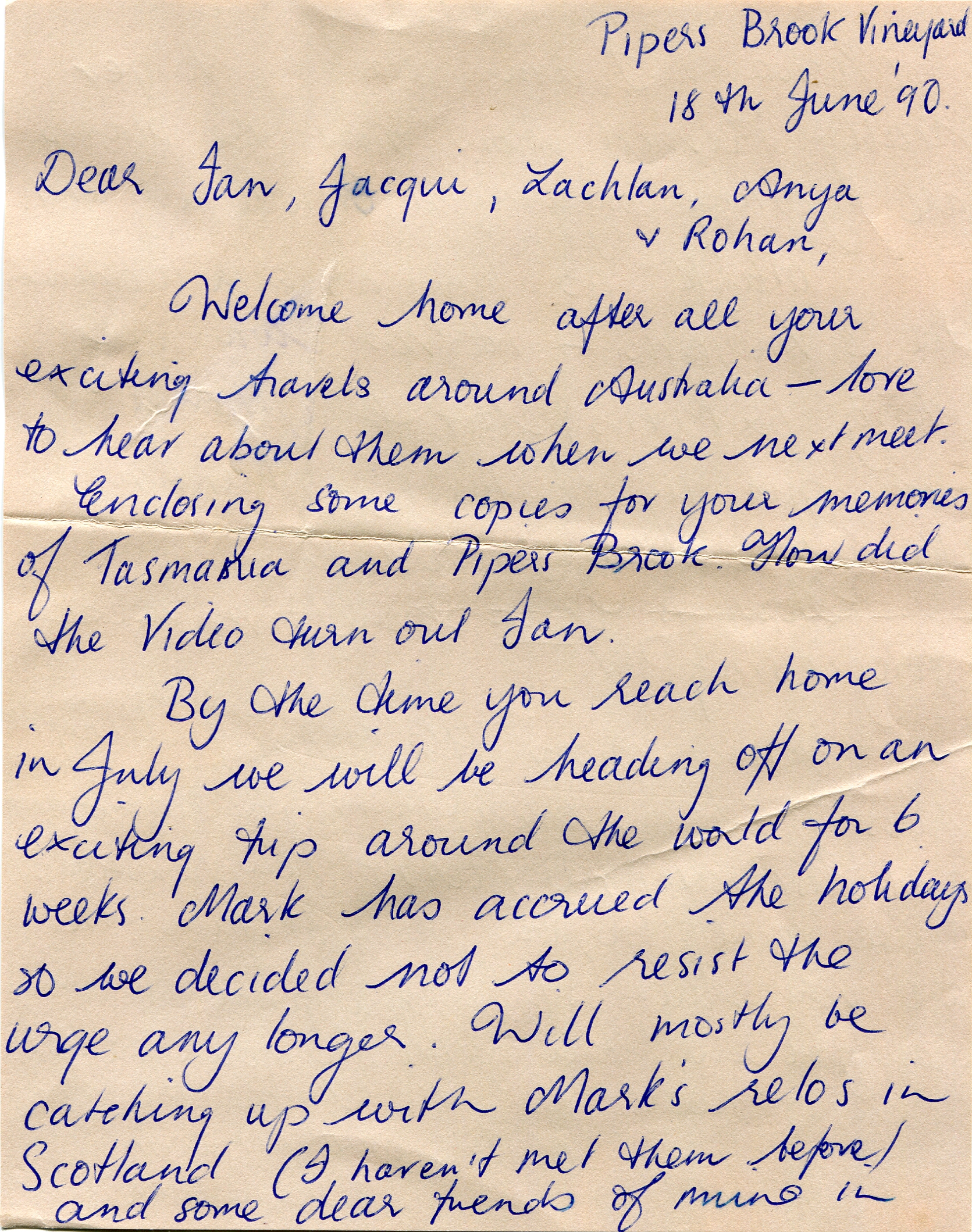
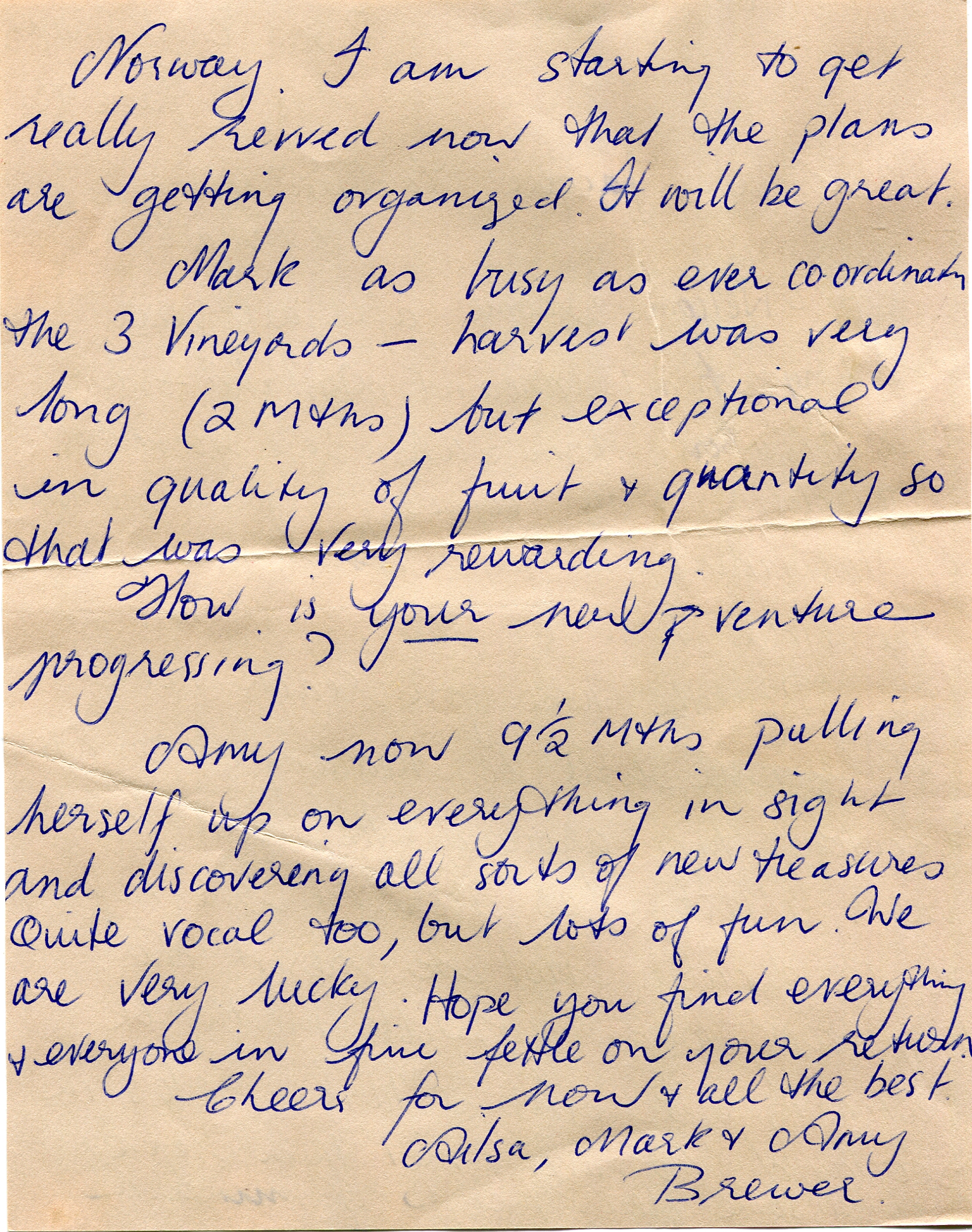
A Christmas card for 1990 received from mark and Ailsa Brewer
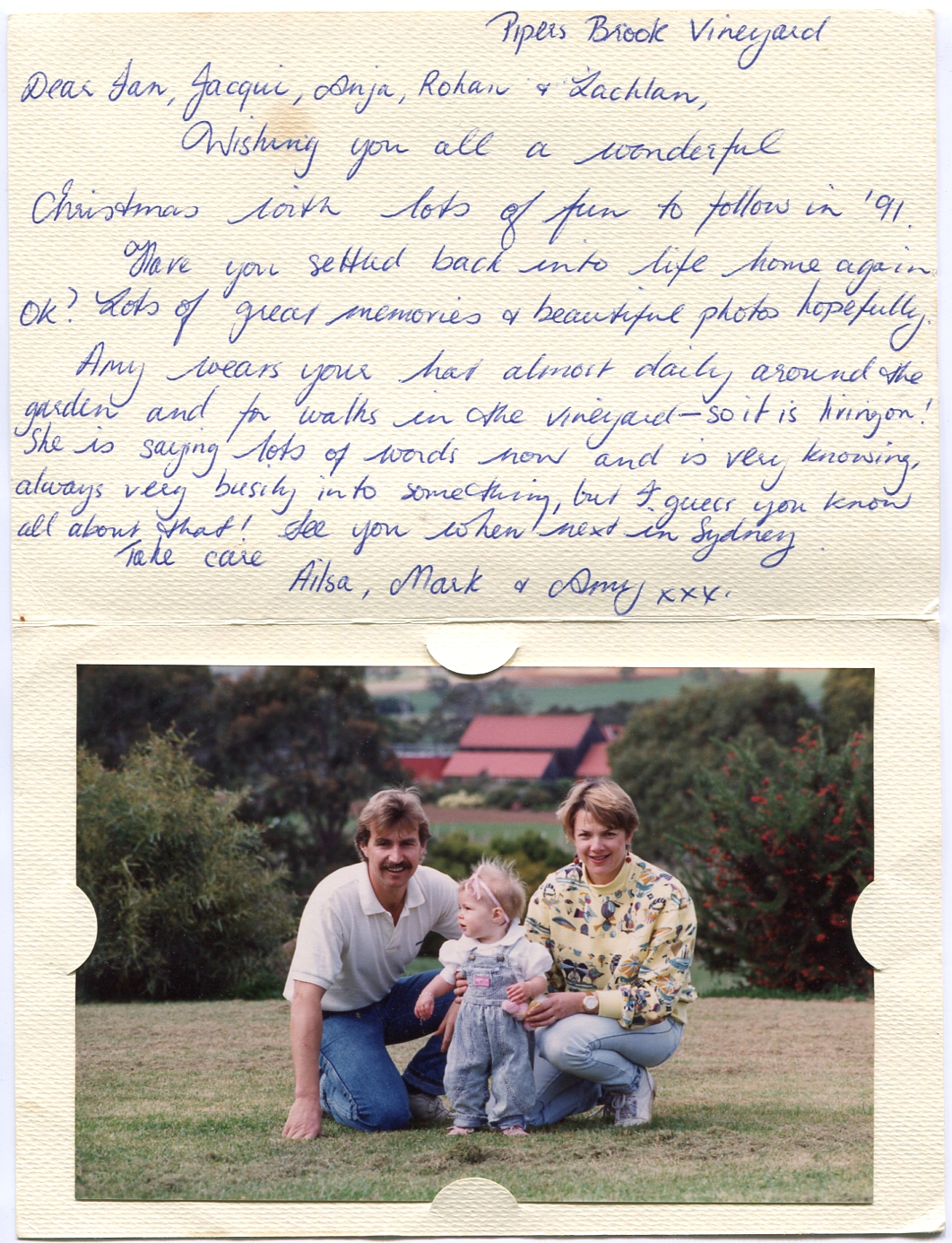
The trip to Devonport was uneventful and we were in Devonport in just over 1½ hours arriving at 3:30 PM. Having decided to save money by not eating on the Abel Tasman, we bought juice, quiches and muesli bars at a supermarket.
Surprisingly, we only spent about 20 minutes on the dock before being waved aboard by the day-glo-orange and white men. One of these gentlemen nearly screwed his head off while giving instructions to two cyclists who circled him as he spoke. This wouldn't have been so bad except that they were on opposite sides of the circle!
On board we zapped up to the observation deck and consumed the recently purchased meal.
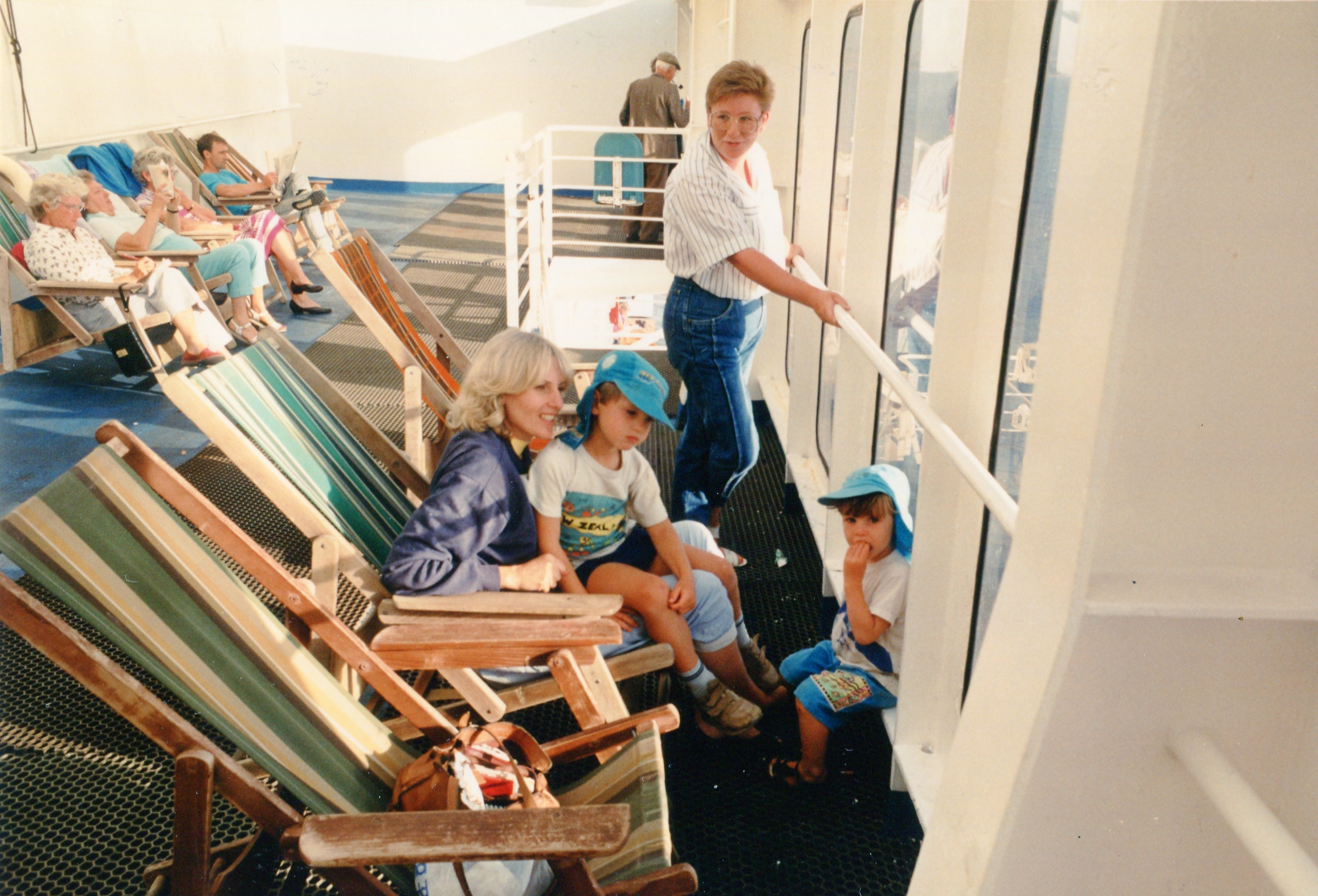
Departing on time at 6:00 PM, the Abel Tasman turned through 360 degrees in its own length with the help of its twin engines and double bow thrusters.
Leaving the Mersey River, we headed north over calm seas. Before dark I had seen several huge schools of fish. We also spotted a school of dolphins that came charging towards the ship, in what appeared to be, a suicide attempt. All they wanted was to romp in the ship’s wake.
Jacqui wasn't feeling sick so had no need for sea sickness pills. We had the kids in bed by about 10:00 PM.
Links to other posts
In the beginning: Motivation and Planning
NSW: Merry Beach, Bournda State Recreation Area
Victoria Pt 1: Mallacoota - Lakes Entrance, Lakes Entrance - Melbourne
Tasmania: 1st - 18th February, 19th - 27th February
Victoria Pt 2: 28th February - 12th March
South Australia: 13th March - 27th March
Western Australia Pt 1: 28th March - 17th April
Western Australia Pt 2: 18th April - 5th May
Northern Territory: 6th May - 17th May
Queensland Pt1: 18th May - 31st May
Queensland Pt 2 to Sydney: 1st June - 20th June